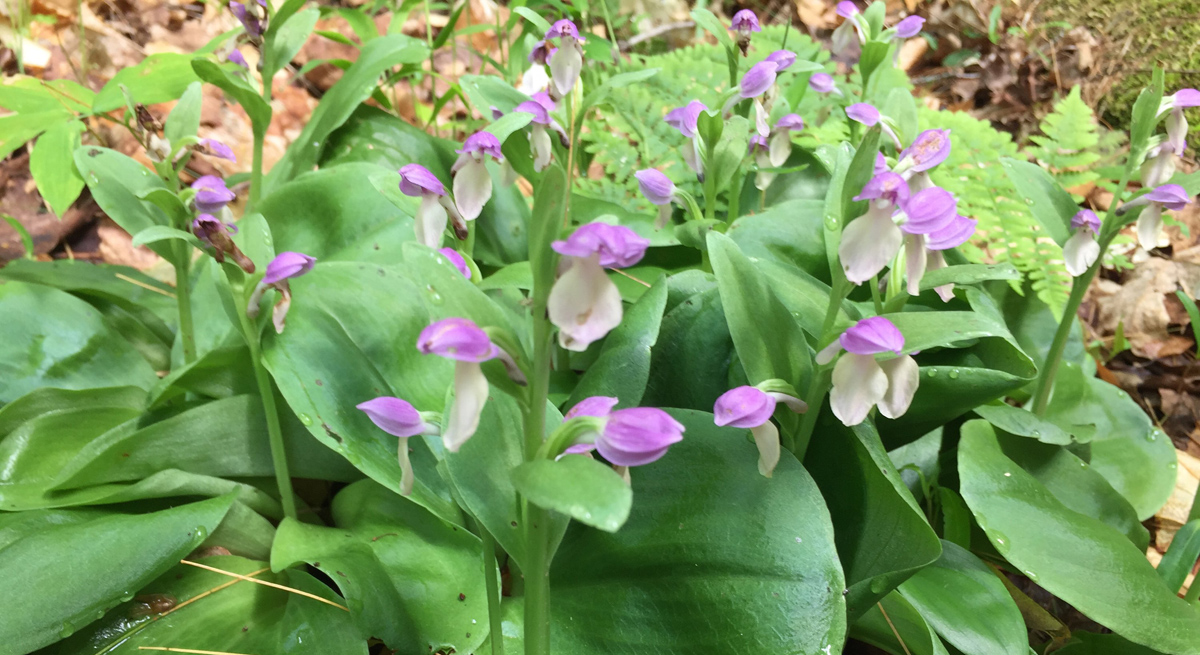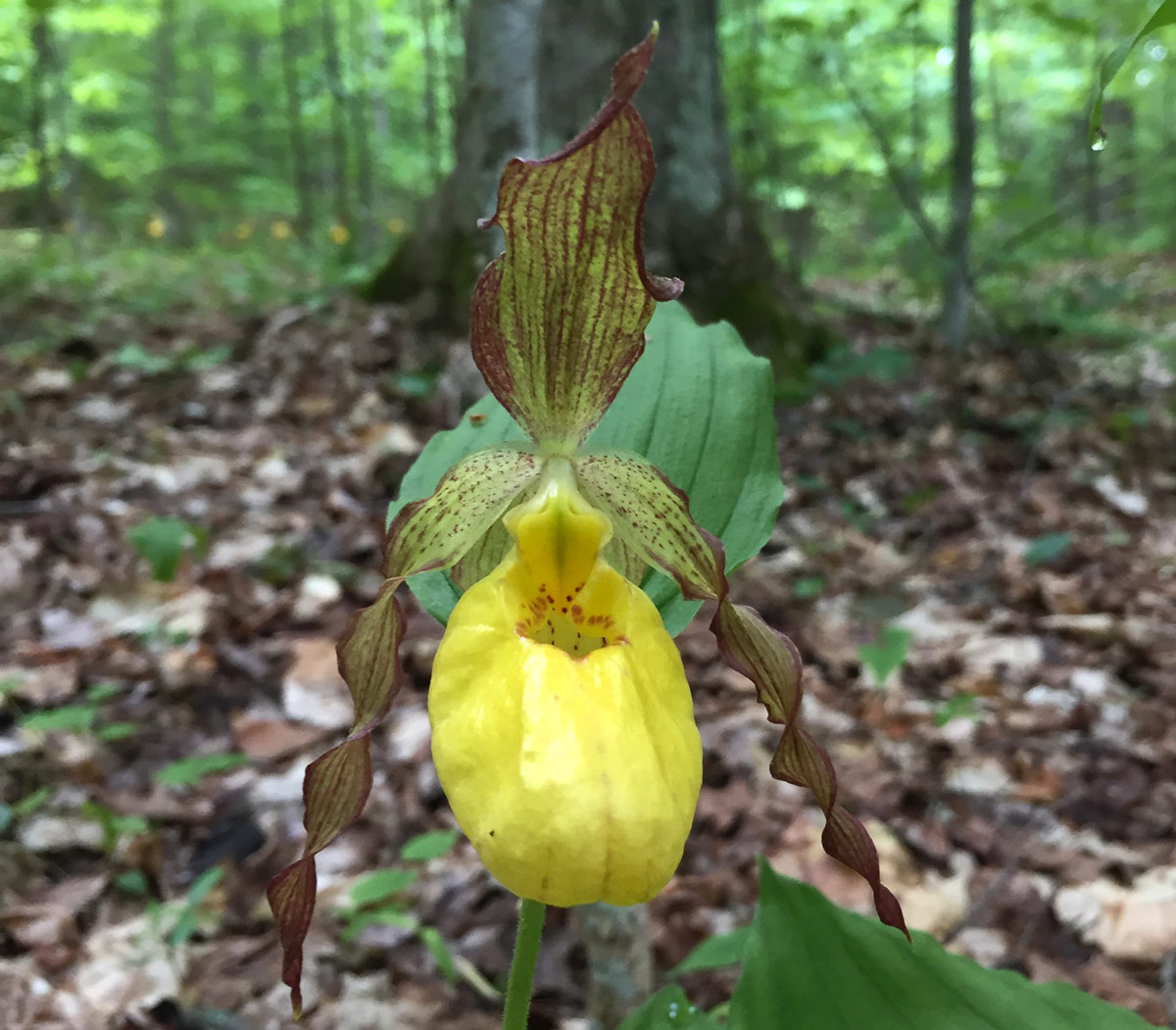Few or no plant families possess the same aura of mystery as the orchids. Most abundant in the tropics, there are more than 20,000 orchid species worldwide in upwards of 1,000 genera. Dazzling and unusual in appearance, the showiest of tropical orchid varieties are considered greenhouse treasures in northern hemisphere botanical collections. Further adding to people’s fascination with these flowers, they are very difficult to propagate outside of their native habitats due to symbiotic relationships with specific fungi and pollinators. The several hundred North American species tend to be elusive and less conspicuous than their tropical counterparts, are terrestrial instead of growing on trees, and are often found only in very specific habitats.
In New England, the most widespread and well-known orchid is the pink lady’s slipper; its arrival announces the progression towards late spring in acidic mixed-pine and oak forests and wet areas region-wide. While common, they, like most orchids, are rarely the dominant plant in their habitats and are a striking reward for the woodland wanderer. New England’s other woodland species are relatively few in number, often categorized as uncommon-to-rare, and typically limited to rich northern hardwood forests. Other uncommon-to-rare orchid species are found in specific types of wetlands such as acidic bogs and calcium-rich fens.
This spring, I was lucky enough to encounter several woodland orchids I had never seen before while visiting land protected by NEFF conservation easements.
In late May, I visited a protected woodlot in the hilltowns of Western Massachusetts with a beaver pond that had newly flooded an old cart road along the property boundary. Diverting my path downstream of the dam, I carefully crossed over mossy hummocks below hemlocks, and was stopped short by a plant quite unfamiliar to me. It had a yellowish-green, smooth stalk about eight inches high, was growing alone without any apparent leaf—basal or otherwise—and had tiny yellowish green flowers with subtle purple spots. I promptly dug out a hand lens and dog-eared wildflower guides from my pack, and after a few minutes of pondering had an ID—early coral-root, or Corallorhiza trifida! In an exaggeration of the orchid family’s highly dispersed nature, this plant was entirely alone—no additional specimen within sight despite my scanning the forest floor around me. Researchers have found early coral root to be “partially myco-heterotrophic,” both utilizing fungi and photosynthesizing for its needed nutrients and carbon.
Another outing in early June started out overcast but comfortable in the central Vermont hills; an overstory of beautiful northern hardwoods with new leaves shaded us as we walked between an understory of striped maple, sugar maple, and beech saplings. The warblers had quieted a little from their May migration madness, though the occasional scolding of Ovenbirds greeted us from down low, and we heard from loftier reaches the high-pitched song of Blackburnian Warblers and the lazy buzzing call of the Black-throated Blue.

Showy orchis patch in Vermont
My companion for the day was Doug Brown, an easement stewardship counterpart from the Upper Valley Land Trust (UVLT), who clued me in to this area’s orchid population. Between UVLT and NEFF, several thousand acres of private land had been protected in these hills since the 1990s. Our showy orchis sighting came first at a site known to Doug. Some had amazing rosy purple petals hooding a white lower lip, while another cluster of plants had fully white flower parts. The showy orchis is uncommon in Vermont, and rare in other New England states.
Not far ahead, we stopped again at a known site of lady’s slippers. Exaggerated yellow pouches with red spots at their openings hung next to twisted petals atop proud upright green plants over a foot tall! Uncommon in much of New England, yellow lady’s slippers are one of the continent’s most widespread orchids—but these were a first for me. Moving on from the UVLT lands, we were thrilled to find two more small patches of showy orchis and an unexpected abundance of yellow lady’s slipper while we explored the NEFF-protected lands.
We walked in contented silence for much of the day, pausing as we walked the boundaries to smell the flowers and listen to the birds. As I looked back through the stunning photos and documented these finds in our written reports, I was reminded how vital a role conservation easements play in the permanent protection of our forested landscape and so many irreplaceable species.

Yellow lady’s slipper
